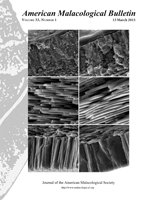The anomalodesmatan family Laternulidae represents a group of bivalves with a very few well-known taxa and many more poorly known taxa. Laternula rostrata (G. B. Sowerby, 1839) and L. anatina (Linnaeus, 1758) occur in close proximity to each other in and along the margins of mangroves of Kungkrabaen Bay, Thailand. Laternula rostrata resides in soft to sandy sediments often within the interstices of mangrove roots located in more open portions of the mangrove mud flat. Laternula anatina lives deeper in the mangrove in more protected environs. Laternula anatina is a smaller bivalve that has a variable shell outline, sometimes a wrinkled shell appearance, thicker periostracum, and frequently extensive umbonal erosion. Both species have high concentrations of external shell spinules anteriorly and closer to the umbos (i.e., in juvenile shell) reflecting functionality in retaining an infaunal position. The larger L. rostrata is thinner shelled and more fragile; has more distinct and longer shell spinules composed of flattened lathes; a glossy external appearance; a longer umbonal slit; and a deeper pallial sinus. Additionally, L. rostrata has a saddle-shaped lithodesma; a lithodesma is absent in L. anatina as is typical of most laternulids. Shell microstructure of both is prismatonacreous, typical of the group, but the prismatic layer is thin and appears truncated into small blocky and/or granular columns in transitional zones. The bulk of the shell is tightly packed sheet nacre. The growth lines in L. rostrata, more pronounced but fewer in number than in L. anatina, appear as shallow rolling “hills” in both the shell and chondrophore. The differences in shell microstructure in these two species are specific to the taxa but based on different habitats and burrowing depths, albeit within the confines of a tropical mangal, could represent biomineralization events that reflect environmental adaptations. Variations in the thickness of the microstructural shell layers of four species of laternulids is compared and we speculate on possible functional and/or environmental relevance of these differences.
How to translate text using browser tools
27 February 2015
Comparative Shell Microstructure of Two Species of Tropical Laternulid Bivalves from Kungkrabaen Bay, Thailand with After-Thoughts on Laternulid Taxonomy
Robert S. Prezant,
Rebecca M. Shell,
Laying Wu
ACCESS THE FULL ARTICLE

American Malacological Bulletin
Vol. 33 • No. 1
March 2015
Vol. 33 • No. 1
March 2015
Anomalodesmata
biomineralization
lantern shell
Laternula
spinule




